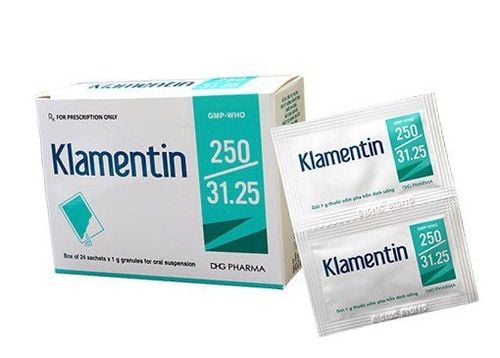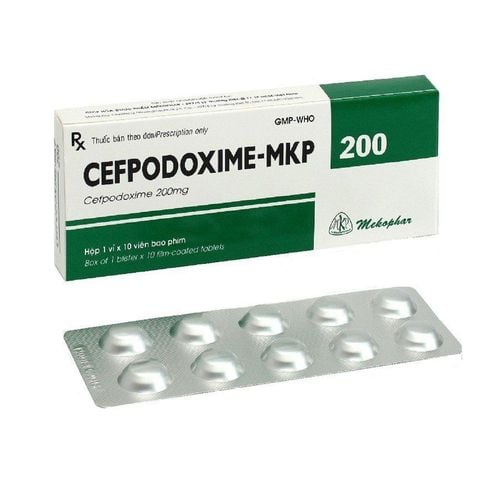This is an automatically translated article.
Vipocef 200 has the main ingredient Cefpodoxime, which is an antiparasitic drug indicated for the treatment of a number of infectious diseases. Refer to information about uses and doses to help patients use the drug effectively.1. What is Vipocef 200?
Vipocef 200 belongs to the group of parasitic drugs, anti-infectives, antivirals and fungicides. The drug contains the active ingredient Cefpodoxime proxetil and many other excipients. The drug is manufactured by Cuu Long Pharmaceutical Joint Stock Company.
Vipocef 200 is made in the form of film-coated tablets that should be taken orally.
2. Indications and contraindications for Vipocef 200
2.1. Indications Vipocef 200 contains the main active ingredient, Cefpodoxime, so it is indicated for the treatment of the following infections:
Upper respiratory tract infections such as pharyngitis, acute otitis media, sinusitis, tonsillitis Pneumonia community-acquired acute. Acute gonorrhea has no complications. Uncomplicated urinary tract infections Soft tissue skin infections 2.2. Contraindications Contraindicated when using Vipocef 200 in the following cases:
Patients with hypersensitivity to cefpodoxime or any of the ingredients in Vipocef 200. Cefpodoxime is not indicated for patients with disease. allergic to cephalosporins, allergic to other beta-lactam antibiotics.
3. Dosage and how to use Vipocef 200
3.1.Usage The patient uses Vipocef 200 orally. Accordingly, patients should take Vipocef 200 after meals to ensure effective drug absorption for the body.
3.2. Dosage Adults
Dosage of drugs to treat upper respiratory infections, tonsillitis, pharyngitis: Use a dose of 100 mg every 12 hours and for a period of 10 days. Dosage for community-acquired acute pneumonia: 200 mg every 12 hours for 14 days. Dosage of drugs to treat acute gonococcal infections without complications: Use a single dose of 200 mg. Dosage of drugs to treat uncomplicated urinary tract infections: The dose is 100 mg every 12 hours for 7 days. Dosage for treatment of skin and skin structure infections: 400 mg every 12 hours for 7-14 days. Children
Treatment of acute otitis media: The dose is 10 mg/kg/day (maximum 400 mg/day divided into 2 times) for 10 days. Treatment of pharyngitis and tonsillitis: Dose of 10mg/kg/day (maximum 200mg/day divided into 2 times) for 10 days. Note: Active ingredient Cefpodoxime should be administered with food. In patients with renal impairment (creatinine clearance less than 30 ml/min), the dosing interval should be increased to 24 hours. In addition, it should be noted that no dose adjustment is required in patients with cirrhosis.
4. Notes when using Vipocef 200
During the use of Vipocef 200, patients need to pay attention to the following issues:
Active ingredient Cefpodoxime is not the preferred antibiotic in the treatment of staphylococcal pneumonia. Accordingly, the drug is also not recommended to be used to treat atypical pneumonia caused by bacteria, such as Legionella, Mycoplasma and Chlamydia. In addition, Vipocef is also not recommended to be used to treat pneumonia caused by S. pneumoniae. As with some beta-lactam antibiotics, the use of Vipocef containing the active ingredient Cefpodoxime has been reported, and even fatal (cases) hypersensitivity reactions have been reported. Therefore, during use, if a patient experiences hypersensitivity reactions, it is necessary to discontinue Vipocef immediately and initiate appropriate emergency measures. Prior to initiating treatment with Vipocef, a history of allergy should be considered and caution should be exercised in patients with a history of hypersensitivity to other beta-lactam drugs. In the case of using Vipocef for patients with severe renal impairment, a dose reduction may be considered depending on creatinine clearance. Bacterial colitis and pseudomembranous colitis have now been reported with most antibacterial drugs, including the active ingredient cefpodoxime, which, if severe, can be life-threatening. threaten. Therefore, it is paramount to consider this diagnosis in patients with diarrhea during or after cefpodoxime administration. Discontinue treatment with Vipocef and require specific therapy for Clostridium difficile. Medicinal products that inhibit intestinal motility should not be used. Vipocef should be used with caution in patients with a history of gastrointestinal disorders, especially colitis. As with beta-lactam antibiotics, neutropenia and agranulocytosis have very rarely occurred in patients on prolonged therapy. In cases where treatment with the drug was prolonged for more than 10 years. Blood counts should be monitored daily, and the drug should be discontinued if leukopenia occurs. Cephalosporins can be absorbed on the surface of the cell membranes of red blood cells and react with antibodies against the drug. This can result in a positive Coomb test and, rarely, hemolytic anemia. Possible cross-reactivity with penicillin in this reaction. Alterations in renal function have been observed with cephalosporin antibiotics, especially when co-administered with potentially nephrotoxic drugs such as aminoglycosides and/or diuretics. In these cases, the patient's renal function should be closely monitored. As with the use of other antibiotics, prolonged use of cefpodoxime may lead to overgrowth of non-susceptible organisms. In some cases, treatment interruption may be necessary. Laboratory Interactions: A positive reaction to a urine glucose test can occur with Benedict's, Fehling's solution, or with a copper sulfate test tablet, but is not based on a glucose oxidase reaction. Vipocef contains lactose, so it should not be used in patients with rare hereditary problems such as galactose intolerance, severe lactase deficiency, glucose-galactose malabsorption. Wheat starch: Vipocef medicine contains starch as an excipient, so it can be used for people with intestinal diseases. However, patients with a wheat allergy should not take this medicine.
5. Side effects of Vipocef 200
During the use of Vipocef 200, patients may experience some side effects with the following frequency:
Common side effects:
Gastrointestinal: Gastrointestinal disturbances, nausea, vomiting, flatulence, abdominal pain, diarrhea. Pseudomembranous colitis can occur if persistent and severe diarrhea occurs during or after treatment. Metabolism and nutrition: The patient loses his appetite. Uncommon side effects
Nervous system: Headache, sleep disturbance, insomnia, dizziness. Ears: Tinnitus. Skin: Hypersensitivity reactions, rash, urticaria, pruritus. Systemic: Asthma, fatigue, irritability Rare side effects
Blood: Hematological disorders: decreased hemoglobin, thrombocytopenia, leukopenia, eosinophilia. Gastrointestinal: Short-term transient increases in ASAT, ALAT, alkaline phosphatase and/or bilirubin. Very rare side effects:
Blood: Hemolytic anemia. Immune system: Bronchospasm, anaphylaxis, purpura, angioedema. Urinary: Slight increase in urea, creatinine Digestion: Liver damage. Skin: Stevens-Johnson syndrome, erythema multiforme, erythema Infection and infection: increase in non-susceptible microorganisms. When experiencing any side effects, the patient should immediately notify the doctor for advice and timely treatment.
6. Using Vipocef 200 on special subjects
Pregnancy: There are currently no data on the use of cefpodoxime in pregnant women. Animal studies have not shown direct or indirect effects on reproductive toxicity. Therefore, pregnant women should only use Vipocef 200 when absolutely necessary. Lactation: Cefpodoxime can be excreted in breast milk in very small amounts, so it can be used for women during this period. However, nursing mothers should only use it under the advice and prescription of a doctor. Driving and operating machines: Vipocef 200 may cause dizziness during treatment. Therefore, patients need to be careful when driving or operating machinery.
7. Vipocef 200 . drug interactions
Drug interactions Vipocef 200 may occur during use as follows:
Absorption of cefpodoxime is reduced when used with drugs with antacids. Therefore, the use of cefpodoxime should be avoided with antacids, H2 antihistamines. Probenecid has the potential to decrease renal excretion of cefpodoxime. Cefpodoxime increases the anticoagulant effect of coumarin, while reducing the contraceptive effect of estrogen. Oral anticoagulants: Concomitant administration of cefpodoxime with the anticoagulant warfarin increases the anticoagulant effect. Increased anticoagulant activity has been reported in patients receiving concomitant antibacterial drugs, including cephalosporins. Risks can vary from infectious cause, age, and physical condition of the patient. Therefore, the presence of cephalosporins leading to an increase in INR is difficult to assess. Therefore, regular monitoring of INR is recommended during and immediately following administration of Vipocef with an oral anticoagulant. Studies have shown that bioavailability is reduced by approximately 30% when cefpodoxime is administered with drugs that neutralize gastric pH or inhibit acid secretion. Therefore, drugs such as mineral antacids, H2 blockers such as ranitidine can increase stomach pH. Therefore, patients should take it 2 to 3 hours after taking Vipocef. If the patient forgets a dose, take the dose as soon as he remembers. Skip the missed dose if it is almost time for your next dose. In case of drug overdose, it is necessary to notify the doctor immediately for advice and treatment.













